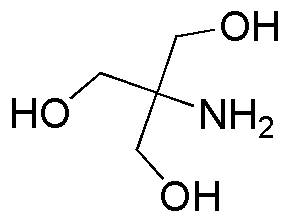Tris(hydroxymethyl)aminomethane is widely utilized in research focused on:
- Biological Buffers: This compound is a key ingredient in buffer solutions, helping to maintain stable pH levels in biological experiments, which is crucial for enzyme activity and cell culture.
- Pharmaceutical Formulations: It is often used in the development of drug formulations, providing a stable environment for active ingredients, enhancing their efficacy and shelf-life.
- Analytical Chemistry: Researchers employ it in various analytical techniques, such as chromatography, to ensure consistent pH conditions, improving the accuracy of results.
- Biotechnology Applications: In molecular biology, it serves as a stabilizer for proteins and nucleic acids, facilitating experiments like PCR and protein assays.
- Cosmetic and Personal Care Products: The compound is also found in cosmetic formulations, where it acts as a pH adjuster, ensuring product stability and skin compatibility.
General Information
Properties
Safety and Regulations
Applications
Tris(hydroxymethyl)aminomethane is widely utilized in research focused on:
- Biological Buffers: This compound is a key ingredient in buffer solutions, helping to maintain stable pH levels in biological experiments, which is crucial for enzyme activity and cell culture.
- Pharmaceutical Formulations: It is often used in the development of drug formulations, providing a stable environment for active ingredients, enhancing their efficacy and shelf-life.
- Analytical Chemistry: Researchers employ it in various analytical techniques, such as chromatography, to ensure consistent pH conditions, improving the accuracy of results.
- Biotechnology Applications: In molecular biology, it serves as a stabilizer for proteins and nucleic acids, facilitating experiments like PCR and protein assays.
- Cosmetic and Personal Care Products: The compound is also found in cosmetic formulations, where it acts as a pH adjuster, ensuring product stability and skin compatibility.
Documents
Safety Data Sheets (SDS)
The SDS provides comprehensive safety information on handling, storage, and disposal of the product.
Product Specification (PS)
The PS provides a comprehensive breakdown of the product’s properties, including chemical composition, physical state, purity, and storage requirements. It also details acceptable quality ranges and the product's intended applications.
Certificates of Analysis (COA)
Search for Certificates of Analysis (COA) by entering the products Lot Number. Lot and Batch Numbers can be found on a product’s label following the words ‘Lot’ or ‘Batch’.
Numéro de catalogue
Numéro de lot/série
Certificates Of Origin (COO)
This COO confirms the country where the product was manufactured, and also details the materials and components used in it and whether it is derived from natural, synthetic, or other specific sources. This certificate may be required for customs, trade, and regulatory compliance.
Numéro de catalogue
Numéro de lot/série
Safety Data Sheets (SDS)
The SDS provides comprehensive safety information on handling, storage, and disposal of the product.
DownloadProduct Specification (PS)
The PS provides a comprehensive breakdown of the product’s properties, including chemical composition, physical state, purity, and storage requirements. It also details acceptable quality ranges and the product's intended applications.
DownloadCertificates of Analysis (COA)
Search for Certificates of Analysis (COA) by entering the products Lot Number. Lot and Batch Numbers can be found on a product’s label following the words ‘Lot’ or ‘Batch’.
Numéro de catalogue
Numéro de lot/série
Certificates Of Origin (COO)
This COO confirms the country where the product was manufactured, and also details the materials and components used in it and whether it is derived from natural, synthetic, or other specific sources. This certificate may be required for customs, trade, and regulatory compliance.


